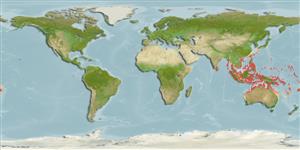>
Syngnathiformes (Pipefishes and seahorses) >
Syngnathidae (Pipefishes and seahorses) > Syngnathinae
Eponymy: Kali Das Bhanot. Dr Sunder Lal Hora’s etymology says the genus was named after his ‘esteemed friend’. (Ref. 128868), visit book page.
More on author: Duméril.
Environment: milieu / climate zone / depth range / distribution range
Ecologia
marino demersale; distribuzione batimetrica 3 - 25 m (Ref. 48635). Tropical
Eastern Indian Ocean and Western Pacific: Andaman Sea to Vanuatu.
Size / Peso / Age
Maturity: Lm ? range ? - ? cm
Max length : 9.0 cm SL maschio/sesso non determinato; (Ref. 5316)
Short description
Chiavi di identificazione | Morfologia | Morfometria
Raggi dorsali molli (totale) : 29 - 35; Raggi anali molli: 3. Head raised with ridge from behind eyes. Indistinct dark bars below head (Ref. 48635).
Found on coral reefs of inshore waters (Ref. 75154). Live openly on muddy or silty substrates (Ref. 48635). Benthic species (Ref. 75154). Ovoviviparous (Ref. 205). Males carry the eggs in their brood pouches (Ref. 205).
Life cycle and mating behavior
Maturità | Riproduzione | Deposizione | Uova | Fecundity | Larve
Male carries the eggs in a brood pouch (Ref. 205).
Dawson, C.E., 1985. Indo-Pacific pipefishes (Red Sea to the Americas). The Gulf Coast Research Laboratory Ocean Springs, Mississippi, USA. (Ref. 5316)
IUCN Red List Status (Ref. 130435: Version 2024-1)
Threat to humans
Harmless
Human uses
Strumenti
Special reports
Download XML
Fonti Internet
Estimates based on models
Preferred temperature (Ref.
123201): 25.2 - 29.3, mean 28.7 °C (based on 2444 cells).
Phylogenetic diversity index (Ref.
82804): PD
50 = 0.6250 [Uniqueness, from 0.5 = low to 2.0 = high].
Bayesian length-weight: a=0.00037 (0.00016 - 0.00085), b=3.18 (2.99 - 3.37), in cm total length, based on LWR estimates for this (Sub)family-body shape (Ref.
93245).
Trophic level (Ref.
69278): 3.3 ±0.5 se; based on size and trophs of closest relatives
Resilienza (Ref.
120179): Alto, tempo minimo di raddoppiamento della popolazione meno di 15 mesi (Preliminary K or Fecundity.).
Fishing Vulnerability (Ref.
59153): Low vulnerability (10 of 100).
